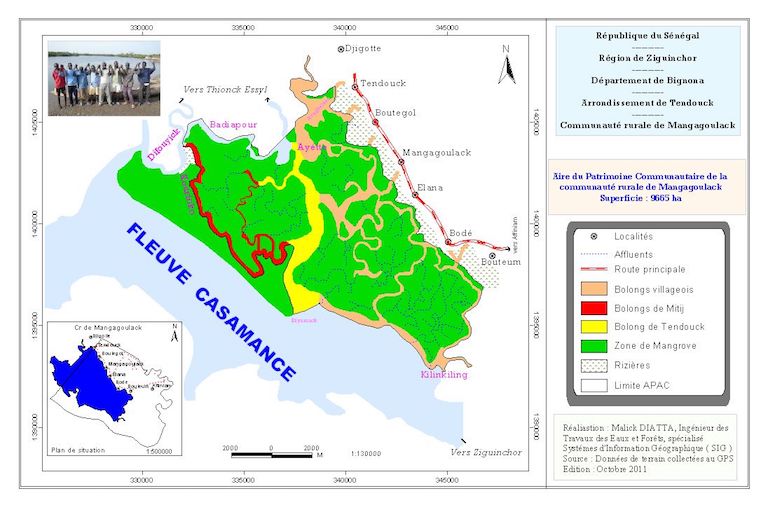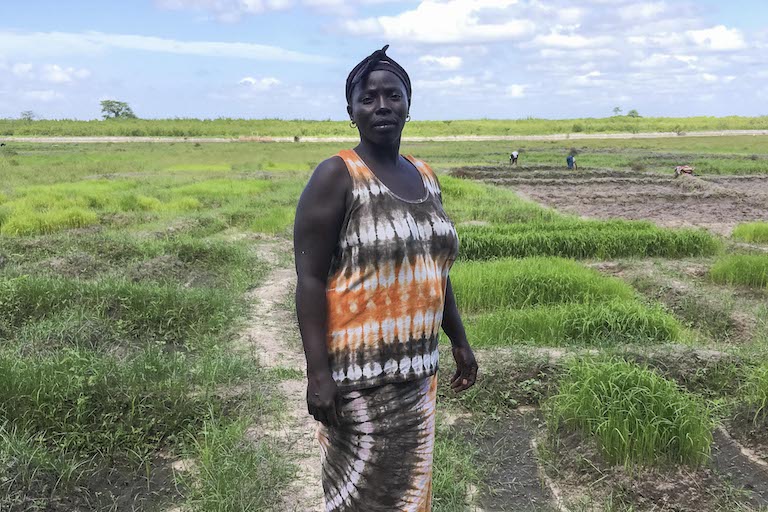- Women, and older women in particular, play important roles in the Kawawana ICCA, an indigenous conservation group in Senegal’s Casamance region.
- They set rules for oyster harvesting and mediate conflicts that arise with outsiders who infringe upon Kawawana rules.
- They also deploy ancient animist traditions in defense of the local environment and act as spiritual doctors for those who break the rules.
- Since 2010, Kawawana has made huge strides in repopulating the local river with fish, reducing damaging levels of salinity in its waters, and halting deforestation, largely by returning to traditional fishing and forestry practices.
This is the third story in Mongabay’s three-part profile of the Kawawana ICCA, read the others here: Senegal: After reviving fish and forests, Jola villages tackle new threats and here: Watching the wildlife return: Q&A with a rural Senegalese river monitor
MANGAGOULACK, Senegal — Women control a key aspect of the Kawawana ICCA, an indigenous conservation group in Senegal’s Casamance region: setting and enforcing the rules for oyster cultivation. Older women, who are highly respected for their knowledge of village tradition and the natural environment, have additional responsibilities. They protect the environment through an authority believed to be vested in them alone, according to ancient animist traditions. They also play a central role in mediating conflicts that arise with outsiders.
The women have contributed to the success of the Kawawana ICCA, which covers eight ethnic Jola villages in the 97-square-kilometer (37-square-mile) Mangagoulack rural municipality. (The term “ICCA” denotes traditional lands conserved by indigenous and local community groups.) After being formalized in 2010, the group made huge strides in repopulating the local river with fish, reducing damaging levels of salinity in its waters, and halting deforestation. It did so largely by returning to traditional fishing and forestry practices.
The 12,000 residents of Mangagoulack depend heavily on the Casamance River for sustenance. Women and men’s roles are strictly divided, with no female fishermen, no male fishmongers, and very few men cultivating oysters. But both play an equal role in providing food for their families, selling goods, and growing rice and vegetables.

Mariama Dieme sits on a committee of 10 sages drawn from the eight villages that make up Mangagoulack and the Kawawana ICCA. The sages are understood to possess powers over the spirit world, an abiding belief in which overlays daily life for the Jola people of Senegal, though most if not all are Christian or Muslim as well.
Dieme’s main role in Kawawana’s conservation activities is placing fetishes made from wood and brightly colored fabric in areas where fishing is restricted, and especially in the Mitij bolong, a channel where fish are left in peace to reproduce. These talismans act as a deterrent to those who come to poach with banned monofilament nets among the mangroves of the Casamance River. Fishermen from the nearby city of Ziguinchor, or in some cases as far away as northern Senegal, fear attracting the wrath of bad spirits, said to be able to inflict illness or bad luck on them and their families.
Dieme said she was frequently visited by people who said they needed help exorcising demons, some of them after committing infractions against the environmental rules imposed by Kawawana, like fishing or chopping wood outside of designated areas.
“People won’t end up in hospital as these are mystical and invisible illnesses, and the only ones who can cure them are us,” she said.
She uses holy water and beats a hollowed-out gourd to treat the patients, and warns them to stick to the rules next time.
“It’s a way of life for us and it’s our culture. We have preserved this from our ancestors and our parents,” Dieme said.
This grandmother’s prayers, “that the fish will come, that the oysters will grow, that the rice will be good for the harvest,” as she puts it, are also viewed as possessing a special power in the community.


Dieme plays the role of mediator when Kawawana’s surveillance patrols come across outsiders fishing illegally in its waters.
“We help to solve conflicts between the surveillance patrols and those who commit infractions,” she said, adding that these arguments can get heated. With the backing of Senegal’s fisheries agency, the Kawawana association can impose heavy fines of up to $535 on poachers, impound their nets and sell their catch.
The women’s work on behalf of Kawawana overlays their traditional roles as family caretakers and food providers. Dieme supports her grandchildren in the village and her unemployed children living in Senegal’s capital, Dakar. “They want to work for the government or as teachers, not as fishermen,” she sighed.
The Kawawana rules helped bring the area’s fish and oysters back from years of overharvesting and return catches to something like what they were in the eldest women’s memories. Mangagoulack’s residents are generally more comfortable and well fed than they were a dozen years ago, before Kawawana began.
But new challenges have arisen and many of the burdens fall on the women. With children and in some cases multiple generations of family to support, women struggle during the rainy season, when oyster beds are rested per Kawawana rules, and there are fewer fish to sell.

“I’m here. What are you going to do to make money? If you don’t sell fish, you have to catch it. That or oysters,” said Souadou Sambou, a 44-year-old fishmonger. “There are some real difficulties during the rainy season. Fish becomes scarce,” she added.
Sambou sells her fish in Bignona, about 35 kilometers (22 miles) away, and she struggles with a lack of refrigerated trucks and the consequent need to constantly replenish ice. After paying for transport and ice, she makes $18 to $27 in profit each time she goes to the market.
In the afternoons, she and the other women in the community toil in the rice fields, maintaining dikes that ensure the water salinity is not too high, which would endanger their crops.
Oyster pickers played a key role in forming the Kawawana association and in laying down rules for harvesting the bivalves sustainably. These are usually women in their 60s or 70s who are also raising grandchildren after their own children joined the exodus from rural communities.

Dienaba Diedhiou, a mother of 10 and grandmother now in her 70s, said she hoped to retire in two years.
“[Decades ago], we would exchange oysters for rice or millet. People would make a selection [of oysters], they would not just cut everything. Today, it’s a business, people do it for money,” she said. “Before, you had to be a woman of a certain age to do it. Now there are teams who go every day to collect them while others grill them. Before, one had to do both, with two days picking and three days grilling and selling.”
Diedhiou and others have begun fining the teams that pick oysters before they are mature, as well as running training sessions for younger women to ensure they don’t kill off the bivalves for the next season.
“You work with your muscles. We don’t use gloves and the oysters cut your hands,” she said. “With climate change, everything is tough. The money I earn is for food, for the children’s school fees, and caring for the health for the family.”

“It’s a question of survival for the community,” said Aissatou Sambou, president of Kawawana’s oyster pickers’ association, to which everyone involved in the trade in Mangagoulack belongs. “When you go to the river to get oysters, you prepare them and you sell them and that keeps your family going.”
Kawawana was formed with the idea that protecting the environment makes it easier to earn a living, and in many ways this has borne out. Sometimes, though, it has been difficult to strike a balance between the two, Sambou said. Kawawana has banned cutting down trees in its villages, so the women cannot construct new canoes to move freely through the river’s waterways.
“If yours is damaged you can no longer get to the oysters,” she said. “That has pushed people back toward poverty.”
Jennifer O’Mahony is a freelance journalist working across West Africa. Follow her on Twitter via @jaomahony.
FEEDBACK: Use this form to send a message to the editor of this post. If you want to post a public comment, you can do that at the bottom of the page.
